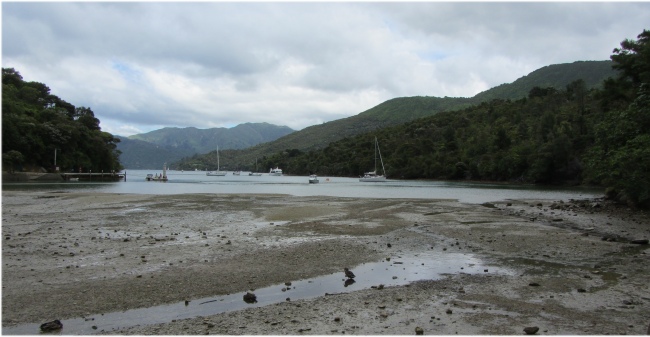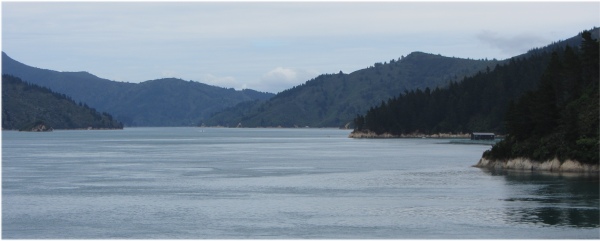Marlborough Sounds, named in honour of the Duke of Marlborough, is a collection of ancient sunken river valleys flooded with the waters of the Pacific Ocean, a legacy of rising sea levels at the end of the last ice-age. It consists of 1500km of almost fractal New Zealand coastline, covering some 4,000 km� of sounds, islands, and peninsulas. The area has three main bodies of water: Queen Charlotte, Kenepuru and Pelorous Sounds. Several islands within the sounds are predator-free sanctuaries for native wildlife, including rare South Island robins on Motuara Island.
Maori were occupying the sounds in the 14th century. Captain James Cook also used the sounds for shelter and food on each of his voyages between 1770-77. He made Ship Cove his favoured base in the 1770s and discovered here a plant (Cook's scurvy grass) that is high in vitamin C to cure scurvy.
The Queen Charlotte Walkway gives a hiker's perspective on the sounds, providing stunning vistas on a 3 to 5 day tramp. An alternate way to appreciate the sound scenery is from the water. The intricate waterways of the Marlborough Sounds create a wonderland for sea kayakers, and with such a coastal expanse, finding a corner to call your own in a sea kayak would not be difficult.
I twisted and turned my way along Queen Charlotte Drive to Linkwater, then took a right along the Kenepuru Road to skirt first the Mahau Sound and then Kenepuru Sound. The glistening waters beside me displayed a thousand shades of colour ranging from the brightest turquoise to the deepest green. Forested hills rose steeply from the sea around an intricate coastline of sheltered inlets and sandy bays. Due to inadequate road access around the sounds, they are sparsely populated. Many of the small dwelling places by the waterside were only accessible by boat. The land immediately to the south of the sounds is also one of the nation's least populated regions.

Mistletoe Bay with the Tide Out
|
I drove as far as Portage, the last point of civilisation, a very small resort. There I took time out and enjoyed a bowl of seafood chowder while watching kayaks glide across the rippled water. Young kids splashed and yelped with glee in the shallow waters, and old people drank tea and read their books on benches below where I sat. The setting reminded me very much of an English spa town, though the landscapes could not match that spread before me.
Once rejuvenated, I turned back along the road and turned off at Te Mahia to follow a very narrow gravel track from Kenepuru Sound to Mistletoe Bay on Queen Charlotte Sound. The campsite there was the only one on this large peninsula which had any facilities, and accordingly was double the cost of sites I had visited before. The caretaker let me park up next to a ditch for the duration, very handy for the mosquitos of course, and I was told that the site was now full.
I needed to walk, not a long walk, just to stretch my legs, so I followed a trail around the small peninsula that the camp was located next to, and then returned to catch up on my blog which I was well behind on. It is a labour of love that I needed to keep on top off. If I slipped a day behind, it was hard work trying to catch up again.
I sat on the bench outside the communal kitchen and started typing. My neighbour at the bench was an Australian woman, a psychologist by profession but now retired. She was tackling the meandering 71km long Queen Charlotte Track over several days, which actually passes through the campsite. Indeed I walked part of it on my mini-hike. "Are you on the internet?" she asked. "No, there are no networks down in this bay at all. I'm catching up on my blog," I explained. "I run a blog," she continued, "the Red Nomad. In Australia, when people retire, sell up and just travel, they are called grey nomads. I decided to dye my hair red and so I am the Red Nomad." She laughed at that point. This was her chosen lifestyle. She had hiked around various parts of her home country, but she wanted to tackle this particular scenic tramp. The arrangement for this track is that the water taxis that ply up and down Queen Charlotte Sound, will also collect luggage from little huts by the jetties and deliver it to little huts at other jetties as dictated by notes attached to the luggage. So the lady had hiked a section of the track, and her luggage had been transported for her, and all she had to do now was go down to the jetty and collect her worldly goods.
When she left, I resumed typing, only to find myself in conversation with another woman, who had just hiked in and was busy collecting her luggage from the little hut by the water taxi jetty. Like me, she had not made a reservation for the night, and she had been told that there was no room at the inn. The poor woman was distraught, and eventually the caretaker relented and found a small slot for the woman's small tent. It was hard to guess the woman's age, but she also had her own alternative lifestyle. She came from Oregon, US, had no husband or children, and liked to travel. With the price of property in the US falling by at least 10% per annum, and set to follow that trend even more steeply for the conceivable future, she had sold up and put what she had regarded as of value into storage. She was content to rent for a while, and jump back onto the housing market when the fall bottoms out. She too was hiking along the Queen Charlotte Track, and had a day left to finish it, before meeting up with her mother who was joining her for three weeks. The pair of them would travel around staying in bed and breakfasts, or couch surfing, a setup in New Zealand where private householders rent out a couch or bed for the night. She had experienced difficulties sorting out air tickets, mainly because Chinese airlines were involved; those airlines seem to leave it rather late to confirm flights, while other operators were screaming at her to commit to flights. Like me, she had bought a round-the-world ticket, but I was staggered to learn that it cost more than three times what I had paid in the UK. A friend of hers had advised her to buy a ticket over the internet from the UK; I had just confirmed her friend's advice.
It was heart-warming to see that women regard New Zealand as a safe country to travel alone in.





